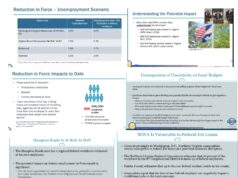By Sean Perryman, a member of the Fairfax County Affordable Dwelling Unit Advisory Board who works as Counsel on the House Committee on Oversight and Government Reform.
“The time is now to move beyond embracing diversity as an asset and implement a new growth model driven by equity—just and fair inclusion into ‘One Fairfax, a community in which everyone can participate and prosper.”
In July 2016, with the above edict, the Fairfax County Board of Supervisors adopted the One Fairfax Resolution, promising to focus “intentionally and deliberately towards sustainable structural changes.”
Ironically, following the adoption of “One Fairfax,” report after report after report confirmed that both the state and county were increasingly economically segregated and were not providing everyone an equal chance to participate.
This string of reports revealed that, in multiple arenas including housing and hiring, there appear to be two different Fairfax counties—one for whites and one for Blacks.
In the latest Fairfax Fair Housing analysis, the report found a dual housing market—one where whites could live anywhere in the county and another market with restricted options for people of color. Blacks were more restricted than any other racial group. Not only did Black residents find themselves steered towards certain areas but, in many cases, they also were paying more to live in the county because lenders pushed them into high-cost loans. This remained true regardless of their income.
Prior to the release of the Fair Housing analysis, George Mason University released a report finding discrimination against Black applicants by Fairfax County Public Schools. Similar to home loans, the normal criteria for applicant success did not seem to help Black applicants. Regardless of having the same education or experience as their white peers, Black applicants were about half as likely to be hired. The results did not significantly change even when Black applicants had more education or experience.
And all of these findings came on the heels of a report by the Commonwealth Institute finding that Virginia schools were becoming more racially and economically segregated.
Discrimination of this magnitude is significant. The Fairfax County Public School system is the largest employer in the county and third largest in the state. The County itself is home to approximately 1.1 million residents, so inequities here resonate throughout the region.
Unfortunately, many of these trends are true at a national level. For example, a study conducted by MIT in 2003 found that resumes from white candidates received 50 percent more interviews than identically qualified applications from Black candidates.
A more recent study by Stanford University actually found that Black and Latino families needed to earn more than white families to live in some of the same neighborhoods.
In many ways, we are dual nation indelibly marked by a history of discrimination. The One Fairfax resolution acknowledges the disparities resulting from that history and attempts to carve a path forward. For that, I commend the county and its leadership.
Uniting the county into a socially and racially equitable place to live, however, requires more.
The new superintendent, Dr. Scott Brabrand, is working towards identifying and rectifying the source of the disparate hiring.
The Board of Supervisors need to be aggressive in addressing the findings of this hiring report. In addition to the adoptions of the recommendations of the most recent analysis, the county needs to test the real estate market for signs of discrimination and use every legal recourse against lenders and brokers engaging in discriminatory practices. This includes litigation, an option that the county has not utilized.
These patterns of discrimination were not incidental. They emerged from the convergence of the private and public sector forces intentionally working for several decades to create dual systems that locked Blacks out of opportunity. Those same forces must now dedicate equal or more time and effort to undo the consequences of discrimination. Now is the time to see if “One Fairfax” is more than wishful thinking.
P.S. For more on the public housing issue, see below.



 Sign up for the Blue Virginia weekly newsletter
Sign up for the Blue Virginia weekly newsletter






![Video: Trump’s Former VA Campaign Chair Says “Youngkin is going to ostracize [Reid] from the ticket, which means that Reid is going to get blown out and can’t raise money.”](https://bluevirginia.us/wp-content/uploads/2025/04/fredericks0428-100x75.jpg)
